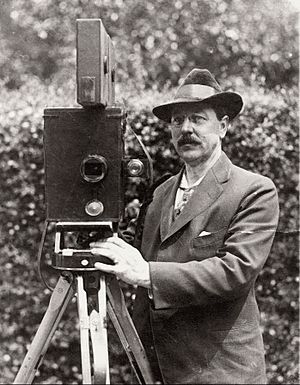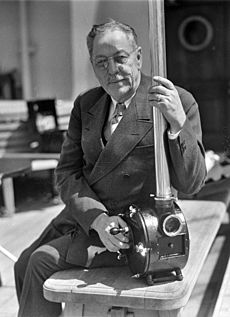Leon Douglass facts for kids
Leon Forrest Douglass (born March 12, 1869 – died September 7, 1940) was an American inventor and businessman. He helped start the Victor Talking Machine Company. Douglass created about fifty inventions, mostly for film and sound recording.
Contents
Early Life and Career
Leon Douglass grew up in rural Nebraska. His father was a carpenter. Leon went to school in Lincoln, Nebraska. At age eleven, he worked as a telegraph messenger. By seventeen, he was managing a telephone exchange for the Nebraska Telephone Company.
Discovering the Phonograph
In 1888, Leon saw a phonograph for the first time and was amazed. A phonograph was a machine that could record and play sounds. He built his own phonograph. He showed it to E.A. Benson, who was the president of the Nebraska Phonograph Co. Benson was impressed and hired Leon.
In 1889, Leon invented a "nickel-in-the-slot" attachment for the phonograph. This meant people could pay a nickel to listen to music or recordings. Benson bought the patent for $500. Leon then got a job with the Chicago Central Phonograph Company. This company was connected to Thomas Edison's phonograph business.
In the early 1890s, Leon invented a machine to make copies of phonograph cylinders. People started calling him "Duplicate Doug" because of this. He sold this invention and worked for a short time in Washington D.C. He then returned to Chicago as a manager.
The World's Fair and New Connections
Leon became Vice President and Treasurer of the Chicago Central Phonograph Company. He arranged for one hundred slot phonographs to be at the 1893 Chicago World's Fair. This was a very popular event. At the fair, he met Peter Bacigalupi from San Francisco. Leon later moved to San Francisco and married Victoria Adams in 1897.
After the Chicago fair, Leon bought the slot phonographs. He then set them up at the 1894 Midwinter Fair in San Francisco. These machines were later used to open a phonograph arcade on Market Street.
Leon also tried to get a contract to show Thomas Edison’s kinetoscope at the World’s Fair. The kinetoscope was an early moving picture device. This would have been the first public showing of moving pictures. But Edison did not agree to a part of the contract, so it didn't happen.
Creating the Victrola
In 1900, Leon teamed up with Eldridge R. Johnson. Johnson owned a machine shop that made parts for phonographs. They started a company called The Consolidated Talking Machine Company. It later became the Victor Talking Machine Company in 1901. Leon said the company was named after his wife, Victoria.
As Vice President and General Manager, Leon was in charge of sales and advertising. He helped make the famous image of the dog listening to "His Master's Voice" popular.
Leon also invented the cabinet and stand for the Victrola. The Victrola was a phonograph built inside a piece of furniture. He thought that people, especially ladies, would prefer a music player that looked like furniture. He wrote that Mr. Johnson improved his design. The Victrola became a huge success. By the 1920s, it was the most popular home entertainment device in America.
In 1906, Leon had some health problems and could not work. He moved his family to San Rafael, California. He offered to resign from Victor, but Mr. Johnson refused. Johnson said that Leon had done so much for the company that they could never repay him.
Innovations in Motion Pictures
Leon also made many important inventions in motion pictures. In 1912, he started working on color film. In 1916, he patented a way to film in "natural color." This was different from hand-coloring films. It was an early step towards Technicolor.
His first movie camera used two negatives, one for red and one for green. These were printed on a special film that showed natural colors when projected. The first showing of films made with this camera was on May 15, 1917.
In 1918, Leon produced Cupid Angling. This might have been the first full-length color film made in America. Famous actors like Ruth Roland, Mary Pickford, and Douglas Fairbanks appeared in it. By 1921, Leon had developed a process that could take color photos much faster. This made it possible to create regular feature films in color.
Victoria Manor and Special Effects
In 1921, Leon moved his family to Menlo Park, California. He bought a large house with 52 rooms. He named it Victoria Manor, after his wife. He set up a workshop in the basement and a laboratory on the mezzanine. Today, this house is called Douglass Hall and is part of the Menlo School and Menlo College.
Leon invented a movie camera with a "triple scene dissolve." This allowed for smooth transitions between scenes. He also patented zoom lenses and the first anamorphic lens. An anamorphic lens helps create wide-angle films without distortion. He also invented devices for special effects, like ghosts appearing and disappearing, or making actors seem to shrink. By the mid-1920s, major movie studios rented his special effects cameras.
In 1927, Leon sold his shares in the Victor company and became very wealthy. Later, in 1934, he sued several large movie studios, including Paramount Pictures and Walt Disney Company. He claimed they were using his "natural color" film patents without permission. He won the lawsuit, and a large financial settlement was reached.
Underwater Cameras
Leon also invented underwater cameras. He had a window put in his swimming pool at Victoria Manor. Through this window, he filmed people swimming underwater. He even filmed his daughters swimming with a seal and wrestling an octopus.
In 1932, Leon joined a scientific trip near Easter Island. He used his submarine cameras to film at depths up to 1,500 feet. He also used an underwater "flashlight" that he invented. In the mid-1930s, he filmed the ocean floor near Pearl Harbor for the US Navy.
Other Inventions
Leon also created inventions in other areas. In 1924, he invented a new type of snap cigarette lighter. One of his sons started a company to sell these lighters.
Later Life and Passing
In 1935, Leon experienced sad family events. He then retired. He and his wife moved to a smaller home. Leon Forrest Douglass passed away in San Francisco at the age of 71.
Selected Inventions
- Slot attachment for phonograph (1889)
- Spring-mounted motor for Edison phonographs (1891-1893)
- Duplication process for phonograph cylinders (early 1890s)
- Semi-cabinet, stand, record cabinet for phonograph (1903-1904)
- First successful subtractive color movie process (1916)
- Triple-scene dissolve movie camera (1921-1922)
- Spring-actuated cigarette lighter (1924)
- Zoom lenses
- Anamorphic lens for wide-angle filming
- Special-effects movie cameras
- Underwater cameras
- Underwater "flashlight"



